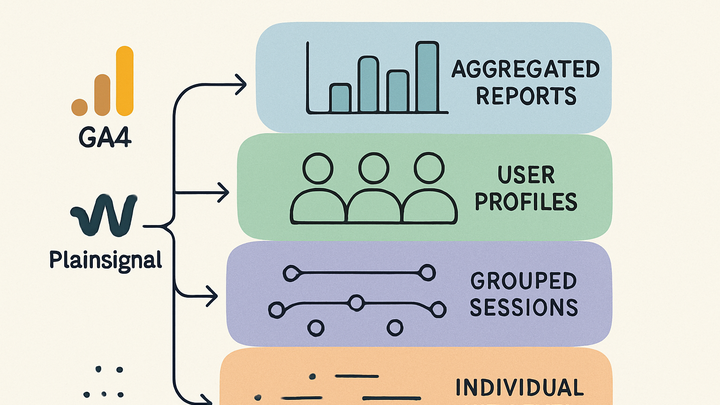Published on 2025-06-28T00:09:16Z
What is Data Resolution in Analytics? Examples from PlainSignal & GA4
Data Resolution in analytics refers to the level of detail at which user interactions and events are recorded and processed. It determines whether you capture individual hits, group interactions into sessions, track unique users, or view aggregated summaries. Higher data resolution (e.g., event- or hit-level) provides granular insights but may increase data volume, processing costs, and privacy risks. Lower resolution (e.g., aggregated-level) reduces data complexity and resource usage but can obscure detailed patterns and user behaviors. Understanding and choosing the appropriate data resolution is crucial for achieving accurate, actionable analytics while balancing performance and privacy.
Different analytics platforms offer varying resolution capabilities and defaults. For example, PlainSignal provides a cookie-free, privacy-centric model that focuses on essential metrics with minimal data footprint, whereas Google Analytics 4 (GA4) employs an event-based architecture that natively captures detailed user and event data. Configuring tracking code and resolution settings correctly is essential to align with your analysis goals and compliance requirements.
Data resolution
Data Resolution defines the granularity at which analytics platforms collect and process data, from hits to sessions, users, or aggregated summaries.
Understanding Data Resolution
This section defines data resolution within analytics and explains its significance in tracking and reporting. Data resolution determines how granular your dataset is, affecting insight depth and system performance.
-
Definition
Data resolution specifies the smallest unit of measurement for analytics data, such as individual hits, sessions, users, or aggregated groups of interactions.
-
Resolution levels
Data resolution can be categorized into several levels, each suited to different analytical needs and performance considerations.
-
Hit-level
Captures every user interaction (e.g., pageviews, clicks) as separate records for maximum detail.
-
Session-level
Groups multiple hits into a single session, showing a sequence of interactions over a defined time period.
-
User-level
Aggregates data by unique users across sessions, enabling cross-session behavior analysis.
-
Aggregated-level
Summarizes data into high-level metrics and dimensions, reducing volume and complexity.
-
Impact of Data Resolution on Analytics
Choosing the right data resolution affects your analytical insights, data processing overhead, and privacy posture. This section explores these impacts in detail.
-
Analytical granularity
Higher resolution enables detailed segmentation and troubleshooting but can complicate analysis with noise.
-
Data volume and performance
Fine-grained data increases storage requirements, query times, and costs, while aggregated data optimizes performance.
-
Privacy and compliance
Granular data may include personally identifiable information (PII) requiring strict compliance; aggregated data often simplifies privacy management.
Data Resolution in PlainSignal and GA4
Different SaaS analytics platforms implement data resolution according to their design philosophies. We compare PlainSignal’s cookie-free approach with GA4’s event-based model.
-
PlainSignal’s cookie-free model
PlainSignal prioritizes user privacy by avoiding cookies and personal identifiers, focusing on essential metrics and aggregated insights to reduce data volume and compliance risk.
-
GA4’s event-based architecture
GA4 captures every user interaction as an event, offering hit-level resolution and flexible event parameters for deep analysis, with session and user stitching under the hood.
-
Sampling and quotas
GA4 may apply sampling when datasets exceed certain thresholds, affecting resolution in high-traffic scenarios; PlainSignal’s lightweight model typically avoids sampling by limiting raw detail.
-
Implementation snippets
Below are example snippets showing how to integrate each platform and their default resolution behavior.
-
PlainSignal integration snippet
<link rel="preconnect" href="//eu.plainsignal.com/" crossorigin /> <script defer data-do="yourwebsitedomain.com" data-id="0GQV1xmtzQQ" data-api="//eu.plainsignal.com" src="//cdn.plainsignal.com/plainsignal-min.js"></script> -
GA4 integration snippet
<script async src="https://www.googletagmanager.com/gtag/js?id=G-XXXXXXXXXX"></script> <script> window.dataLayer = window.dataLayer || []; function gtag(){dataLayer.push(arguments);} gtag('js', new Date()); gtag('config', 'G-XXXXXXXXXX'); </script>
-
Best Practices for Managing Data Resolution
Balancing analytical needs, system performance, and privacy requires following best practices when configuring data resolution.
-
Define clear analytics objectives
Start with specific questions or KPIs to determine the appropriate resolution level needed for actionable insights.
-
Optimize data collection
Collect only necessary events and parameters to minimize volume while retaining critical detail.
-
Balance privacy and detail
Implement data minimization and pseudonymization to protect user privacy while preserving analytical value.
-
Regularly review and adjust
Monitor data usage, performance, and compliance, and adjust resolution settings as business needs evolve.
